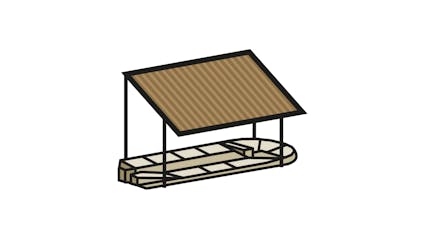852 – Public Laundering Pavilion from Bodio TI, 19th Century
In the central Alps and in southern alpine zones beating the wash was common – women used open air laundry spots on brooks, covered laundering pavilions or wash houses for the purpose.

Wooden Wash Troughs …
A widely employed type of laundering used ash lye: hot water was poured over a bed of wood ashes in large tubs situated above the articles to be washed. The lye leaching out of the ashes wet the laundry and loosened the dirt. The public laundry from Rüschlikon (612) demonstrates such laundering practice.

… or Stone Washboard?
There is also a variation in which the laundry is swung or beaten against a hard surface. In the central Alps and in southern alpine zones beating the wash was common – women used open air laundry spots on brooks, covered laundering pavilions or wash houses for the purpose. The public laundry of Bodio, known here as a “lavatorio”, did not stand in the midst of the village as usual, but was quite a way off on the mountainside where a warm spring lightened the work.

Open Pavilion
At its original location this building resembled a carport of the 1950’s or an improvised shed: four steel columns stood on small concrete footings and carried a pitched roof of corrugated iron. The inlet and outlet of the basin were hewn from natural stone, while in between a shallow tub about three metres wide and five metres long (10 feet by 16) and lined with small stones served for washing.
Hard Labour
There are sloping granite slabs on both long sides of the tub. The women knelt behind them and beat the wash against the granite slabs. A weir at the outlet permitted damming the water for rinsing as in a wash trough.
Ballenberg
Swiss Open-Air Museum
Museumsstrasse 100
CH-3858 Hofstetten bei Brienz
Company holidays
24 December 2025 to 11 January 2026
Opening hours Administration
3 November 2025 to 8 April 2026
From Monday to Friday
8.30 am to 11.30 am
1.30 pm to 4.30 pm
Opening hours
9 April to 1 November 2026
10 am to 5 pm daily